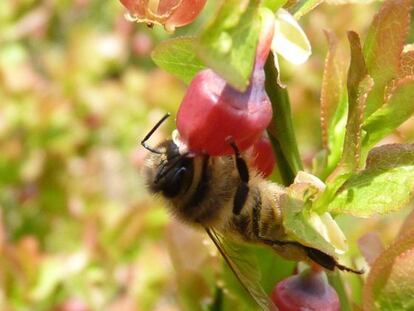Honey bees as metal detectors
An NGO has teamed up with a mining company to assess the environmental risks of reopening an Asturias goldmine

An analysis of the nectar and pollen that was collected by 40,000 bees from two hives has been enough to establish that a goldmine that the company Asturgold intends to reopen in Salave - located close to the community of Tapia de Casariego, in Asturias - is not contaminated.
The idea for this novel approach to assessing the state of the mine came from environmental NGO Fapas, the Fund for the Protection of Wild Animals.
"It is a simple, quick, natural, and efficient method," says its director Roberto Hartasánchez. It is also cheap. The full analysis, which detects heavy metal particles, cost just 300 euros. The sample will be used as a guide to compare with other tests, should the plan to reopen the mine go ahead. It will also allow for the detection of any further impact on the area around Salave, which is largely unspoiled.
Asturgold, a mining company based in Asturias and Vancouver, contacted Fapas in search of a viable way to protect the biodiversity of the area around the mine in a bid to prevent further criticism from the local community, which is concerned about the impact that its plans to develop the area will have. Fapas says that it readily agreed to participate, seeing the experiment as a way to develop a mine that could be considered environmentally friendly. "The impact of the coal mining industry on the area has been horrendous," Hartasánchez admits.
The bees have helped to detect levels of lithium, molybdenum and silver, as well as heavy metals such as aluminum, arsenic, barium, cadmium, cobalt, copper, chrome, strontium, iron, manganese, mercury, nickel, titanium, vanadium and zinc. "These are elements that are present in the environment, and we now know that they are within the appropriate ranges in the area under study," adds Hartasánchez.
In July of last year, Fapas installed two hives near the goldmine. Both had new queens, to guarantee that everything they produced had its origins in the area under study. The bees are estimated to cover an area of around five square kilometers. To further ensure the reliability of the samples taken, Fapas extended the area under study to 3,000 square meters around the hives, covering a total area of at least 28 square kilometers.
Two months later, in September, boxes were introduced into the hives to collect the pollen. Hartasánchez says that he and his colleagues at Fapas waited until the fall "to prevent the bees from visiting just one area that was under flower." As the plants that the bees visited feed on the nutrients in the soil, any contamination from seepage into the water system would be reflected. The same principle applies to measuring air pollution, he says.
The reopening of the mine - which is one of the biggest gold deposits in Europe that has yet to be exploited, and which was once worked by the Romans - was given a positive evaluation in terms of environmental impact back in December. A plan for a treatment plant and a storage system for waste materials was, however, rejected. While the final decision as to whether or not to reopen the mine is taken, the army of bees will continue to produce their regular reports.
Tu suscripción se está usando en otro dispositivo
¿Quieres añadir otro usuario a tu suscripción?
Si continúas leyendo en este dispositivo, no se podrá leer en el otro.
FlechaTu suscripción se está usando en otro dispositivo y solo puedes acceder a EL PAÍS desde un dispositivo a la vez.
Si quieres compartir tu cuenta, cambia tu suscripción a la modalidad Premium, así podrás añadir otro usuario. Cada uno accederá con su propia cuenta de email, lo que os permitirá personalizar vuestra experiencia en EL PAÍS.
¿Tienes una suscripción de empresa? Accede aquí para contratar más cuentas.
En el caso de no saber quién está usando tu cuenta, te recomendamos cambiar tu contraseña aquí.
Si decides continuar compartiendo tu cuenta, este mensaje se mostrará en tu dispositivo y en el de la otra persona que está usando tu cuenta de forma indefinida, afectando a tu experiencia de lectura. Puedes consultar aquí los términos y condiciones de la suscripción digital.
Últimas noticias
Half of Scotland is in the hands of 420 property owners
From digital curfews to blocking apps: How technology experts protect their children online
Why the price of coffee has skyrocketed: from Brazilian plantations to specialty coffee houses
Confined to a Cuban hospital: When electricity is a matter of life or death
Most viewed
- Why we lost the habit of sleeping in two segments and how that changed our sense of time
- Trump’s obsession with putting his name on everything is unprecedented in the United States
- Charles Dubouloz, mountaineering star, retires at 36 with a farewell tour inspired by Walter Bonatti
- The Florida Keys tourist paradise is besieged by immigration agents: ‘We’ve never seen anything like this’
- Living in a motorhome due to soaring housing prices in Madrid: ‘I got used to it quickly, but I don’t idealize it’









































